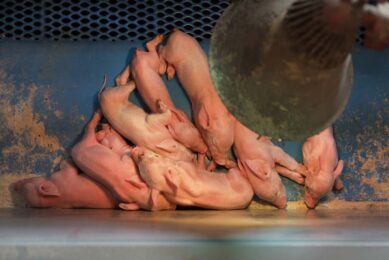Lowering lactose
Unfortunately, piglets require expensive lactose to switch successfully from sow’s milk to cereal energy sources. How much lactose is truly essential?
The truth is, when feed cost goes up, expensive ingredients are squeezed out of formulas. And, dairy products, which are used mainly for their lactose contribution in piglet diets, are expensive compared to other sources of energy!
Unfortunately, piglets require lactose to switch successfully from sow’s milk to cereal energy sources. But, how much lactose is truly essential?
Role
First, let’s describe the role of lactose. Primarily, lactose is a simple energy source that is readily digested and absorbed by the immature gastrointestinal system of piglets. In contrast, starch is a complex carbohydrate that requires elaborate digestion, for which the digestive apparatus of recently weaned pigs requires several days, if not weeks, to fully adapt.
That lactose is used as an energy source by young pigs is proved by the fact that in numerous studies lactose has been successfully replaced by other simple sugars such as sucrose and dextrose.
Nevertheless, lactose also promotes growth and proliferation of gastrointestinal bacteria that secrete lactic acid, maintaining thus an acidic environment that prohibits pathogens, such as E.coli, from taking over. Thus, lactose can be certainly reduced in this role when other ingredients contribute to lowering gastrointestinal pH, right? Well, that’s the theory, but presently it lacks hard evidence…
Normal commercial conditions
Studies have repeatedly shown that pigs housed under normal commercial conditions benefit from high levels of lactose in the first feed post-weaning. Up to 30% dietary lactose increases feed intake and growth in a linear fashion. Yet, in some cases such high levels of lactose may cause secretory diarrhoea, which is often perceived as pathogenic as it is usually followed by secondary E.coli complications.
The reason is simple, lactose is a known laxative for several decades now and unless this is taken into consideration during formulation, pigs usually produce either ‘soft faeces’ or a ‘watery diarrhoea’.
In most cases this does not affect performance, but it certainly causes producers and veterinarians some anxiety over possible pathogenic complications.
Appropriate levels
So, for all apparent reasons, lactose despite being an essential nutrient for piglets must be used at appropriate levels to reduce feed cost and prevent scours. Certainly, some recommendations are needed here, but please bear in mind these should be verified by your nutritionist and veterinarian as different farms have specific requirements that cannot all be included here.
With this disclaimer in mind, I suggest to reduce lactose levels by 5% in your current post-weaning formula, assuming it contains now at least 15% lactose. In other words, 10% lactose in the first diet post-weaning is what I would consider as the absolutely minimum for acceptable performance. In healthy farms, most likely no loss of performance will be noticed although pigs may reduce slightly their feed intake. In other farms, the expected reduced performance should be weighed against the achieved savings from providing a diet with less lactose.
Second diet post-weaning
The second diet post-weaning, which usually contains half as much lactose as the first diet, may be lowered to 5% total lactose, especially when pigs are healthy and feed intake during the first week post-weaning has been strong (over 150 grammes/day).
Following this diet, which is usually fed for 10 to 14 days, the next feed may contain no lactose as pigs rarely benefit from this nutrient during the later nursery period. Instead, they always appear to benefit from a highly-digestible source of protein.
Again, use caution when lowering lactose levels. It is best to reduce levels in two or three progressive steps and select the optimal lactose level that ensures satisfactory feed intake and low enough cost. And, when feed prices become normal again, don’t forget to bring lactose levels back where feed intake becomes maximal. Pigs having a good start always finish faster and more efficiently. It just makes cents!
Join 18,000+ subscribers
Subscribe to our newsletter to stay updated about all the need-to-know content in the pigsector, three times a week. Beheer
Beheer










 WP Admin
WP Admin  Bewerk bericht
Bewerk bericht